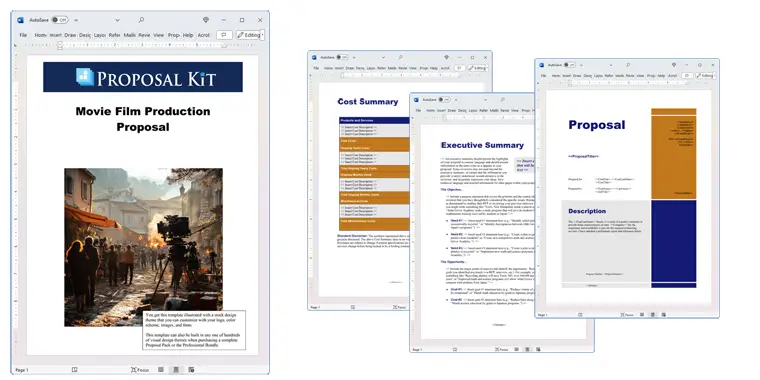How to write your Movie Film Production Proposal
We include this 33 page layout with every Proposal Pack. If you want this template to have a different visual design theme than the one illustrated here, purchase any Proposal Pack design and create this template using the purchased design theme. This template is included in every Proposal Pack. If you get a Proposal Pack or the Professional Bundle, you can also make any variation of this template with different chapters to suit your needs.
We typically include more chapters in the templates than most people will need to give everyone more variety in the chapters they may need. You can trim down a long template by removing pages you do not need or combining multiple chapter topics into one page.
 DOWNLOADABLE, ONE-TIME COST, NO SUBSCRIPTION FEES
DOWNLOADABLE, ONE-TIME COST, NO SUBSCRIPTION FEES If you need only this template pre-assembled on DVD media order from our Amazon shop.
If you need only this template pre-assembled on DVD media order from our Amazon shop.
You can also create countless variations of this document to suit your needs using the included library of 2200+ chapters if ordering a Proposal Pack or Pro Bundle.
 What Our Clients Say
What Our Clients SayThe Proposal Kit helped me present a professional drafted proposal to potential customers."
Public Accountant
Related Article
Related Video
Related Templates
- Short Film Funding Proposal
- Movie Pitch Proposal
- Audio/Visual Production Proposal
- Video Production Services Proposal
- Intellectual Property Rights Licensing Proposal
- TV Pilot Program Proposal
- Talent Agency Services Proposal
- Voiceover Recording Services Proposal and Contract
- Talent Scout Services Proposal
What's the Best Way to Write Your Movie Film Production Proposal?
The Proposal Kit template and software package is the solution for creating a winning movie film production proposal. This software provides customizable templates and incorporates a comprehensive line item quoting database system. This feature aids in creating detailed cost summaries, quotes, estimates, budgets, and other financial chapters crucial to your proposal.
Are you tasked with writing a proposal for a movie or film project? If so, the Proposal Kit will streamline your process and enhance your presentation.
What Types of Projects Are Movie Film Production Proposals Written For?
Movie film production proposals cater to various situations with unique requirements and details. Here are some projects that proposals are written for:
- Feature-length films
- Independent films
- Documentary projects
- Short films
- Animated movies
- Educational films
- Music videos
- Web series
- Biographical films
- Adventure films
- Science fiction movies
- Historical films
- Horror movies
- Romantic films
- Comedy specials
- Thriller projects
- Culturally specific films
- Experimental film projects
- Reality TV show pilots
- Advertising campaigns involving film content
Chapters this template is built with
There is no universal template that fits every scenario in movie production. The Proposal Kit software helps tailor and create proposals to specific needs using an extensive library of chapter templates. Here are some of the chapters related to movie production proposals:
Cover Letter
The cover letter introduces your project and team, setting the stage for the detailed proposal to follow. In this section, you can briefly explain the significance of your movie, introduce key team members, and outline your primary objectives. A strong cover letter will engage the reader's interest and encourage them to look further into your proposal.
Introduction
This chapter outlines the purpose of your proposal and gives an overview of the movie's vision. It serves as a roadmap for the reader, summarizing the film's genre, target audience, and unique elements that make it compelling. This section sets the stage and context for the rest of the proposal.
Executive Summary
Summarize your proposal's key points, emphasizing the movie's potential and financial details. The executive summary should encapsulate the project's goals, funding requirements, anticipated returns, and marketability. This allows stakeholders to grasp the project's viability and financial outlook quickly.
Getting Started
Discuss initial steps and pre-production activities and outline the project's foundation. This chapter can include script development, initial location scouting, and early-stage budgeting. It's important to demonstrate your preparedness and planning capabilities.
Location Analysis
Analyze potential filming locations and their benefits to the production's visual and logistical needs. This section should consider accessibility, costs, local talent availability, and how the location enhances the film's aesthetic. Providing photographic references and logistical maps can strengthen your analysis.
Sales Plan
Describe how you plan to sell and distribute the movie in various markets. This could include domestic and international sales strategies, film festivals, and direct-to-consumer platforms. Highlighting previous sales successes or market research can add credibility to your plan.
Production Plan
Detail the technical topics of the production process from start to finish. This will cover equipment, crew requirements, shooting schedules, and production design. Break down each phase, from pre-production and principal photography to post-production, ensuring a clear path to project completion.
Marketing Plan
Outline strategies for promoting the movie to reach the intended audience. Discuss social media campaigns, press releases, trailers, posters, and other promotional materials. Partnerships with influencers or media outlets should also be considered to maximize exposure.
Merchandising
Explore opportunities for additional revenue through branded merchandise. Detail plans for items like T-shirts, posters, action figures, and other collectibles that can generate income and promote the film. Include examples of potential designs and market analysis to show feasibility.
Promotion
Detailed specific promotional activities are planned to boost visibility and audience reach. This might involve premiere events, red carpet screenings, influencer partnerships, and participation in film festivals. Explain how each activity will contribute to building buzz around the film.
Staffing
Outline your team's structure, introducing key personnel and their roles. Provide brief bios and relevant experience for each team member, highlighting previous successful projects. This helps to build confidence in your team's ability to execute the project.
Treatment
Present a detailed synopsis of the film's story, style, and content. This should give a concise narrative covering the plot, character arcs, and thematic elements. The treatment should be engaging and reflective of the film's envisioned tone and pacing.
Editing
Discuss the post-production editing process and the expected outcomes. Address topics like editing style, pacing, special effects, and sound design. Also, mention software and equipment choices and timelines for completing the editing phase.
Investment
Detail the financial investments required and their projected impacts on the project. Break the financial needs into pre-production, production, post-production, and marketing. Explain how funds will be allocated and the expected return on investment.
Time to Market
Estimate how long it will take from production to official release. Provide a timeline that includes pre-production, filming, post-production, and distribution phases. This helps stakeholders understand project duration and deadlines.
Production Schedule
Provide a timeline for each phase of the project, ensuring clear expectations. Use Gantt charts or other visual aids to map key milestones and deadlines. This helps to demonstrate your organizational skills and ability to manage complex projects.
Media
Plan for the creation and distribution of media content related to the film. This could include behind-the-scenes footage, interviews, trailers, and social media content. Detail how each media type will engage and grow your audience.
Risk Factors
Identify potential risks in the project and propose mitigation strategies. This might include financial risks, production delays, and unforeseen legal issues. Explain how you will address each risk to reassure stakeholders of your preparedness.
Plot Outline
Delve deeper into the narrative structure and character development. Provide a scene-by-scene breakdown or a detailed outline that covers significant plot points, conflicts, and resolutions. This helps readers understand the story's depth and complexity.
Resources
Detail all physical and intangible resources needed to complete the film. This includes locations, props, costumes, software, and intellectual property rights. Listing these resources shows the practicality and thorough planning behind your project.
Permits and Licenses
Identify necessary legal documentation and how you plan to obtain them. This includes filming permits, music licenses, and other essential legal approvals. Discuss your strategy for navigating bureaucratic processes to keep the project compliant.
Auditions
Explain the casting process and outline major casting calls. Detail how you plan to find and select actors, including audition dates, locations, and criteria. Mention any casting directors involved and their previous successes to add credibility.
Sources of Funds
Detail different funding sources for the project, including investors and grants. List each source, the amount expected, and the status of each funding request. This provides a clear picture of your financial backing and the feasibility of project completion.
Budget
Provide a detailed financial plan specifying all expected expenses and incomes. Break down costs into categories like cast, crew, equipment, locations, post-production, and marketing. Include a contingency plan to manage unexpected costs.
Project Summary
Recap the project's scope, highlighting its creative and commercial prospects. Summarize the key points from each section, emphasizing the project's potential success and its broader impact. This gives a final compelling argument for why stakeholders should support your film.
About Us
Introduce your production company, its history, and previous projects. Highlight your company's mission, values, and achievements. Provide examples of past successes to build credibility and trust with stakeholders.
Resume
Include professional resumes of key team members to strengthen credibility. Detail their relevant experience, skills, and past projects. This helps demonstrate that your team has the expertise to execute the project.
Distribution
Outline plans for distributing the film across different platforms and regions. Discuss potential deals with distributors, film festivals, digital platforms, and theatrical releases. Mention any existing distribution agreements to show advanced planning.
Talent
Discuss critical actors, directors, and other talents attached to the project. Provide bios and highlight their previous work, awards, and reputation in the industry. This adds value to your proposal by associating it with well-known and respected professionals.
Reference Material
Include any articles, data, or previous works that support your proposal's goals. This might include market research, demographic studies, previous project analyses, and critical reviews. Reference material helps to substantiate your claims and adds depth to your proposal.
Use cases for this template
Expanding the Reach of Cultural Heritage Films
The Challenge
Working for Cultural Echoes Productions, George faced the challenge of securing funding for a documentary series on indigenous music traditions. The project aimed to document and preserve the cultural heritage of indigenous communities through their music. However, George needed help conveying the project's significance and securing funding from diverse cultural foundations and sponsors.
The Solution
He turned to the Proposal Kit for assistance. Using the detailed financial and project templates available, George could outline the documentary's unique topics and immense value. The Proposal Kit provided a structured way to present the project's goals, target audience, expected outcomes, and budget requirements.
The Implementation
George customized the Investment and Resources chapters to highlight the project's cultural significance and the potential impact it could have on preserving indigenous music traditions. He included detailed descriptions of the communities involved, the historical context of the music, and the long-term benefits of documenting these traditions. He also used the Media and Promotion chapters to show how the documentary would reach a broad audience.
The Outcome
The proposal was compelling and resonated with cultural foundations and potential sponsors. As a result, George secured sufficient funding and partnerships from several cultural foundations. The project moved forward, and the documentary series started its production with the support of a dedicated team and adequate financial resources.
Swift Proposal Creation for Independent Cinema
The Challenge
Julia, an assistant at IndieFlick Ventures, was tasked with preparing a proposal for a new indie film project titled Whispering Shadows. With a deadline and limited experience in proposal writing, Julia faced significant pressure. The project needed to secure funding quickly to meet its production schedule and avoid delays.
The Solution
Julia leveraged Proposal Kit's comprehensive templates to streamline the proposal creation process. She focused mainly on the Production Plan and Budget sections, which were critical for convincing potential investors of the project's feasibility and financial planning.
The Implementation
Using an AI writing tool, Julia incorporated industry-specific data from IndieFlick Ventures' website to efficiently fill out the necessary details. She customized the Production Schedule, Time to Market, and Staffing chapters to present a clear timeline, budget, and team structure. The AI tool also helped her refine the Executive Summary to capture the project's vision and financial needs.
The Outcome
The proposal was completed in time and presented to the stakeholders. The detailed and well-structured proposal impressed the investors, who appreciated the clear financial planning and realistic production timelines. Consequently, the project quickly moved into the pre-production phase, ensuring that Whispering Shadows would start filming as scheduled.
Non-Profit Documentary Project RFP
The Challenge
Carlos, a director at GreenWorld, needed to write an RFP (Request for Proposal) for a documentary on environmental conservation titled Guardians of the Earth. The RFP aimed to attract experienced filmmakers and production companies to bid on the project. Carlos faced the challenge of clearly outlining the project's scope, expectations, and evaluation criteria to ensure a successful bidding process.
The Solution
Carlos structured the RFP using the Proposal Kit. The software provided templates that allowed him to clearly define the project's goals, scope, and requirements. He focused on creating detailed sections to provide potential bidders with all the necessary information to submit competitive proposals.
The Implementation
Carlos created a thorough Project Summary to introduce the documentary's objectives and significance. He then detailed the Risk Factors, highlighting potential challenges and mitigation strategies. The Distribution chapter outlined how the documentary would be disseminated to maximize impact. By providing this level of detail, Carlos ensured potential bidders understood GreenWorld's expectations and could tailor their proposals accordingly.
The Outcome
The RFP attracted experienced filmmakers and production companies, resulting in a highly competitive selection process. The clarity and thoroughness of the RFP allowed GreenWorld to evaluate the bids and select the best team for the project. Guardians of the Earth moved forward with a talented production team, ready to raise awareness about environmental conservation through compelling storytelling.
Conclusions and Recommendations
Proposal Kit simplifies the creation of movie film production proposals. Whether securing funding, planning production, or marketing a film, Proposal Kit provides essential tools to create persuasive and comprehensive proposals. This versatility ensures that no matter the type or scope of the film project, you have the resources to present a case to stakeholders.
Also Known As
This template may also be referred to in different ways or be used in more specialized situations, such as:
- Movie Production Business Proposal
- Film Project Investment Pitch
- Cinema Production Funding Proposal
- Independent Film Financing Plan
- Documentary Production Bid
- Feature Film Proposal Outline
- Movie Making Business Plan
- Film Industry Project Proposal
- Cinematic Production Quote
- Visual Media Funding Request
Abstract
 Creating a movie film production proposal is a challenging task that involves numerous topics, including financial projections and artistic vision. A compelling proposal can attract investors and potential funders, highlighting the film's plot, style, and main characters. To write a film proposal, one must navigate the proposal process, which includes a detailed breakdown of estimated costs and a budget breakdown. This requires a keen understanding of the film's full potential and the ability to communicate this to various parties, including producers and executive producers.
Creating a movie film production proposal is a challenging task that involves numerous topics, including financial projections and artistic vision. A compelling proposal can attract investors and potential funders, highlighting the film's plot, style, and main characters. To write a film proposal, one must navigate the proposal process, which includes a detailed breakdown of estimated costs and a budget breakdown. This requires a keen understanding of the film's full potential and the ability to communicate this to various parties, including producers and executive producers.
In such a way, a film proposal template becomes important, offering a visual representation of the project's scope through topics like a mood board and a one sentence summary. The template helps in showcasing investment opportunities and instilling confidence among stakeholders by providing a clear financial outlook. It includes necessary components such as financial projections, a comprehensive film grant proposal, and a short film proposal, which are crucial for securing film grants and engaging potential funders.
The Proposal Kit provides a robust solution for anyone looking to write a film proposal. Its complex document assembly capabilities and extensive content libraries equip filmmakers with the tools needed to present a well-organized and persuasive proposal. With topics like location analysis, sales and production plans, and marketing strategies, the Proposal Kit helps ensure all critical topics of the project are covered. By offering resources that highlight the film's style, audience engagement strategies, and risk mitigation plans, the Proposal Kit aids in creating a proposal that captures the essence of the film while addressing the practicalities of production.
 Overall, the Proposal Kit helps filmmakers to present their ideas, making them well-equipped to navigate the learning curve of proposal writing and bring their cinematic visions to life.
Overall, the Proposal Kit helps filmmakers to present their ideas, making them well-equipped to navigate the learning curve of proposal writing and bring their cinematic visions to life.
In the competitive world of film production, creating a proposal that resonates with stakeholders is crucial. The Proposal Kit serves as an indispensable tool in this process, allowing writers to construct a narrative and showcase their project's strengths. It helps filmmakers instill confidence in potential investors by providing a well-structured proposal deck that highlights financial projections, artistic vision, and investment incentives. By offering a comprehensive background on the project's subject, the Proposal Kit ensures that filmmakers are well-equipped to present a narrative that aligns with the audience's interests and expectations.
The Proposal Kit also facilitates effective communication with potential partners, enabling filmmakers to establish a strong foundation for future collaborations. Access to its extensive library of templates allows for seamless integration of key topics such as contracts, location analysis, and production schedules. This ensures that every topic of the proposal is planned and presented, leaving no room for oversight. By detailing the project's financial needs and potential returns, the Proposal Kit aids in attracting investment and securing the necessary funding to bring the project to life.
 Furthermore, the Proposal Kit encourages filmmakers to engage in an iterative process where feedback is continuously incorporated to refine the proposal. This dynamic approach helps track progress and make necessary adjustments, ensuring the proposal remains relevant and compelling. By linking the film's narrative to broader cultural and market trends, filmmakers can create a proposal that not only captures attention but also lays the groundwork for a successful career in the industry.
Furthermore, the Proposal Kit encourages filmmakers to engage in an iterative process where feedback is continuously incorporated to refine the proposal. This dynamic approach helps track progress and make necessary adjustments, ensuring the proposal remains relevant and compelling. By linking the film's narrative to broader cultural and market trends, filmmakers can create a proposal that not only captures attention but also lays the groundwork for a successful career in the industry.
Ultimately, the Proposal Kit provides the tools necessary to navigate the complexities of proposal writing, allowing filmmakers to focus on their creative vision. Whether it's the intricacies of financial planning, the nuances of character development, or the technical topics of camera work, the Proposal Kit supports filmmakers in every course of their journey. This comprehensive approach transforms the challenging task of proposal writing into a manageable and rewarding endeavor, paving the way for exciting opportunities and successful film projects.
In the field of film production, where creativity meets commerce, a well-articulated proposal is not just a formality but a vital document that can significantly impact the project's trajectory. The Proposal Kit is an invaluable resource for filmmakers, enabling them to create proposals that not only outline the financial and logistical topics but also capture the imagination of potential investors and partners. By detailing where money will be allocated and the anticipated financial outcomes, the Proposal Kit helps filmmakers present a clear and compelling case for investing in their project.
 One of the standout features of the Proposal Kit is its ability to streamline access to an extensive array of templates and services that cater specifically to the unique needs of the film industry. From writing contracts to designing production schedules, the kit provides filmmakers with the tools needed to efficiently manage each phase of their project. This ensures that filmmakers are not only prepared to face the challenges of production but are also ready to seize opportunities as they arise.
One of the standout features of the Proposal Kit is its ability to streamline access to an extensive array of templates and services that cater specifically to the unique needs of the film industry. From writing contracts to designing production schedules, the kit provides filmmakers with the tools needed to efficiently manage each phase of their project. This ensures that filmmakers are not only prepared to face the challenges of production but are also ready to seize opportunities as they arise.
The Proposal Kit also facilitates the development of strong relationships with stakeholders by presenting a professional image that instills trust and confidence. By inviting potential partners and investors to engage with a polished and comprehensive proposal, filmmakers open the door to fruitful exchanges and collaborations. This professional presentation is crucial when it comes time for stakeholders to sign on to the project, as it reflects a level of preparedness and commitment that is often rewarded in the industry.
Furthermore, the Proposal Kit allows filmmakers to keep their audience in mind by considering how their film will appear on the screen and the impact it will have on viewers. It encourages filmmakers to think about the watching experience, from the initial idea to the final cut, ensuring that every topic of the proposal aligns with the ultimate goal of engaging the audience.
 In today's fast-paced film industry, where the pressure to deliver is ever-present, the Proposal Kit stands out as a vital tool that helps filmmakers navigate the often complex proposal process. Providing a comprehensive framework for proposal writing ensures that filmmakers do not forget any critical components, allowing them to focus on bringing their creative visions to life while confidently navigating the business topics of filmmaking.
In today's fast-paced film industry, where the pressure to deliver is ever-present, the Proposal Kit stands out as a vital tool that helps filmmakers navigate the often complex proposal process. Providing a comprehensive framework for proposal writing ensures that filmmakers do not forget any critical components, allowing them to focus on bringing their creative visions to life while confidently navigating the business topics of filmmaking.
Frequently Asked Questions
What is the most important element to include in a movie film production proposal?
The most important element in a movie production proposal is the Executive Summary. This section succinctly captures the essence of your project and its financial needs. It should outline the film's concept, target audience, projected revenue, and key selling points. A well-written Executive Summary can grab the attention of potential investors and stakeholders quickly, making them more interested in reading the rest of your proposal.
How detailed should the budget section be in a movie film production proposal?
The budget section in a movie film production proposal should be highly detailed, listing all expected expenses and potential incomes to provide transparent financial insights. Include every cost element, including pre-production, production, post-production, marketing, and distribution expenses. Detail your sources of funds, whether from investors, grants, or other means. This transparency helps build trust with financial backers and demonstrates thorough planning.
Can Proposal Kit help with proposals for non-commercial films?
Yes, the Proposal Kit includes templates suitable for commercial and non-commercial films, such as documentaries, educational films, and indie projects. Its extensive library allows you to customize templates to fit the specific needs of your non-commercial film project. For example, you can emphasize the project's cultural or educational value in the Treatment and Marketing Plan chapters.
What if my film project spans multiple countries?
If your movie film production proposal involves filming in multiple countries, addressing this in the Location Analysis and Permits and Licenses chapters is crucial. These sections should discuss the logistical and legal considerations, such as obtaining filming permits, navigating different legal requirements, and managing cross-border transportation of equipment and crew. Detailing these topics will show your preparedness and commitment to tackling international challenges.
How can I make my movie film production proposal stand out?
To make your movie production proposal stand out, customize the Treatment and Marketing Plan chapters to highlight your film's unique topics and market appeal. In the Treatment section, provide a narrative that captivates potential investors and stakeholders. In the Marketing Plan, outline innovative strategies for promoting the film, targeting niche markets, and using social media. Use visuals and real-world examples to make your proposal more engaging and persuasive.
15% Off Discount
 Add To Cart Proposal Pack for Any Business
Add To Cart Proposal Pack for Any Business
 Add To Cart Proposal Kit Professional Bundle
Add To Cart Proposal Kit Professional Bundle
 4.7 stars, based on 846 reviews
4.7 stars, based on 846 reviewsProposal Kit chapters used in this template
Cover Letter, Title Page, Table of Contents, Introduction, Executive Summary, Plot Outline, Treatment, Production Plan, Location Analysis, Staffing, Resources, Investment, Sources of Funds, Budget, Risk Factors, Talent, Auditions, Permits and Licenses, Production Schedule, Editing, Time to Market, Sales Plan, Marketing Plan, Merchandising, Media, Promotion, Distribution, Reference Material, Project Summary, Getting Started, About Us, Resume, Back Page
Line Item Automated Chapters
If you purchase a Proposal Pack or the Professional Bundle, these proposal pages are generated using an automated line-item database in the included Wizard software.
Production Schedule, Budget Three Year
You use this proposal for
- General business proposal
- Non-technical proposal
- Project pitch proposal
- Business plan, loan, investor funding proposal
- Entertainment or event planning proposal
How to create this template with Proposal Pack Wizard
You can create this document using any of the logo-designed Proposal Packs. Pick any Proposal Pack with a logo design theme you like best; they will all work equally well. The Proposal Pack for Any Business is the pack with no extra added logos or colors - designed to be used plain or for you to customize with your logos and graphics.
The Proposal Pack design theme you purchase will determine the visual look of this template. The screenshot above only shows the plain generic design theme. Names and stories in examples are fictional; however, the templates are from real client use cases.
We include a library of chapters to be assembled based on your needs. All proposals are different and have different needs and goals. We designed Proposal Pack so you can customize the documents to suit your needs.
You will best create this document using the Proposal Pack Wizard - Expert Edition software to select this template and build it in the Proposal Pack logo design theme of your choice along with any desired customizations (such as adding additional chapters, removing unneeded chapters, changing the order of chapters, and importing your company logo). This template outlines a proposal for the described situation. Each user is responsible for typing in the actual content of the provided pages with their information to complete the proposal. Suggestions in the abstract may include features in higher-end packages and are facilitated by the selection of chapter templates to support the narrative of each proposal, which help guide the user in filling in the details.
The Wizard software's AI Writer will write the content of the pages of the template based on details provided for your company, client, project, financial details and other writing instructions. This will provide a personalized version of the template completely written and ready to edit.
You create this template using the Wizard software with an entire Proposal Pack library and software. We include the Expert Edition of the software in the Proposal Kit Professional bundle. Microsoft Word for Windows is required to use the customizing software. You can also edit Word document templates in other office software such as Word for Mac. We will assist Mac users in assembling complex templates for their first project if they do not have the required platform to run the Wizard software.
How to Build Templates Featured on Proposal Kit Website
Many people find the Proposal Kit website after searching for a specific proposal. Once you've purchased and installed the software, how do you build that template you found in the first place? This video shows you how to build any proposal you see on the Proposal Kit website.
Key Takeaways
- The Movie Film Production Proposal is built using the included Wizard and is a template layout available in the software.
- You can create unlimited custom variations of this template using a Proposal Pack or the Professional Bundle.
- Using a Proposal Pack or Professional Bundle, you can automate quotes and other financial pages with a line-item database.
- There are no ongoing subscription fees. You get lifetime unlimited use.
- We made Proposal Kit for freelancers, small businesses, and non-profits.
- Use of the AI Writer is optional and requires separate purchase of AI Credits to use.
 Ian Lauder has been helping businesses write their proposals and contracts for two decades. Ian is the owner and founder of Proposal Kit, one of the original sources of business proposal and contract software products started in 1997.
Ian Lauder has been helping businesses write their proposals and contracts for two decades. Ian is the owner and founder of Proposal Kit, one of the original sources of business proposal and contract software products started in 1997.By Ian Lauder
 Published by Proposal Kit, Inc.
Published by Proposal Kit, Inc.


 Cart
Cart


 Get 15% off ordering today:
Get 15% off ordering today: 

 Facebook
Facebook YouTube
YouTube Bluesky
Bluesky Search Site
Search Site